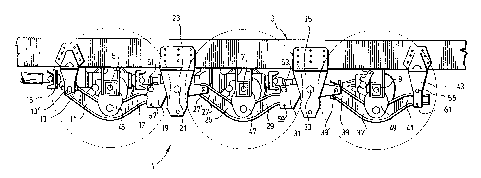Some of the information on this Web page has been provided by external sources. The Government of Canada is not responsible for the accuracy, reliability or currency of the information supplied by external sources. Users wishing to rely upon this information should consult directly with the source of the information. Content provided by external sources is not subject to official languages, privacy and accessibility requirements.
Any discrepancies in the text and image of the Claims and Abstract are due to differing posting times. Text of the Claims and Abstract are posted:
| (12) Patent: | (11) CA 2356022 |
|---|---|
| (54) English Title: | TRIDEM AXLE SUSPENSION |
| (54) French Title: | SUSPENSION D'ESSIEU TRIDEM |
| Status: | Term Expired - Post Grant Beyond Limit |
| (51) International Patent Classification (IPC): |
|
|---|---|
| (72) Inventors : |
|
| (73) Owners : |
|
| (71) Applicants : |
|
| (74) Agent: | ROBIC AGENCE PI S.E.C./ROBIC IP AGENCY LP |
| (74) Associate agent: | |
| (45) Issued: | 2009-07-21 |
| (22) Filed Date: | 2001-08-29 |
| (41) Open to Public Inspection: | 2003-02-28 |
| Examination requested: | 2006-07-21 |
| Availability of licence: | N/A |
| Dedicated to the Public: | N/A |
| (25) Language of filing: | English |
| Patent Cooperation Treaty (PCT): | No |
|---|
| (30) Application Priority Data: | None |
|---|
A tridem axle suspension for use in a vehicle having a front axle, a medium axle and a rear axle mounted in tridem relationship. It makes use of rigid beams to support the axles. It also makes use of equalizers to interconnect the beams, and it is devised in such a manner that one end of each beam is free to slide within the adjacent supporting structure. This suspension is very simple in structure and very efficient to equalize the load of any axle over all the axles of the tridem. When the axles are motorized, the suspension is also efficient to balance the pulls exerted by the wheels supported by the axles.
Suspension d'essieu tridem pour utilisation dans un véhicule doté d'un essieu avant, d'un essieu médian et d'un essieu arrière montés en tridem. La suspension comprend des poutres rigides qui supportent les essieux, de même que des stabilisateurs servant à interconnecter les poutres. La suspension est conçue de façon à ce que l'une des extrémités de chaque poutre soit libre de glisser dans la structure de support adjacente. La structure de cette suspension est très simple et permet de répartir efficacement la charge d'un essieu particulier sur tous les essieux du tridem. Lorsqu'une force motrice est appliquée aux essieux, la suspension permet également de répartir efficacement les forces de traction exercées par les roues supportées par les essieux.
Note: Claims are shown in the official language in which they were submitted.
Note: Descriptions are shown in the official language in which they were submitted.

2024-08-01:As part of the Next Generation Patents (NGP) transition, the Canadian Patents Database (CPD) now contains a more detailed Event History, which replicates the Event Log of our new back-office solution.
Please note that "Inactive:" events refers to events no longer in use in our new back-office solution.
For a clearer understanding of the status of the application/patent presented on this page, the site Disclaimer , as well as the definitions for Patent , Event History , Maintenance Fee and Payment History should be consulted.
| Description | Date |
|---|---|
| Inactive: Expired (new Act pat) | 2021-08-30 |
| Common Representative Appointed | 2019-10-30 |
| Common Representative Appointed | 2019-10-30 |
| Change of Address or Method of Correspondence Request Received | 2018-12-04 |
| Letter Sent | 2017-05-31 |
| Inactive: Multiple transfers | 2017-05-15 |
| Maintenance Request Received | 2014-08-15 |
| Maintenance Request Received | 2013-06-07 |
| Inactive: Correspondence - MF | 2010-08-10 |
| Grant by Issuance | 2009-07-21 |
| Inactive: Cover page published | 2009-07-20 |
| Inactive: Final fee received | 2009-04-23 |
| Pre-grant | 2009-04-23 |
| Letter Sent | 2009-03-30 |
| Notice of Allowance is Issued | 2009-03-30 |
| Notice of Allowance is Issued | 2009-03-30 |
| Inactive: Approved for allowance (AFA) | 2009-03-09 |
| Letter Sent | 2006-08-10 |
| Request for Examination Requirements Determined Compliant | 2006-07-21 |
| All Requirements for Examination Determined Compliant | 2006-07-21 |
| Request for Examination Received | 2006-07-21 |
| Application Published (Open to Public Inspection) | 2003-02-28 |
| Inactive: Cover page published | 2003-02-27 |
| Inactive: First IPC assigned | 2001-10-25 |
| Inactive: Filing certificate - No RFE (English) | 2001-09-13 |
| Filing Requirements Determined Compliant | 2001-09-13 |
| Letter Sent | 2001-09-13 |
| Application Received - Regular National | 2001-09-13 |
There is no abandonment history.
The last payment was received on 2009-05-14
Note : If the full payment has not been received on or before the date indicated, a further fee may be required which may be one of the following
Please refer to the CIPO Patent Fees web page to see all current fee amounts.
Note: Records showing the ownership history in alphabetical order.
| Current Owners on Record |
|---|
| EMMANUEL SIMARD & FILS (1983) INC. |
| Past Owners on Record |
|---|
| ANDRE-MARIE SIMARD |
| REJEAN LAVOIE |